Research Projects and Interests
Life, Death and Embodiment Among Tibetan Buddhists in China: The Early 1980s Tours of the Tenth Panchen Lama
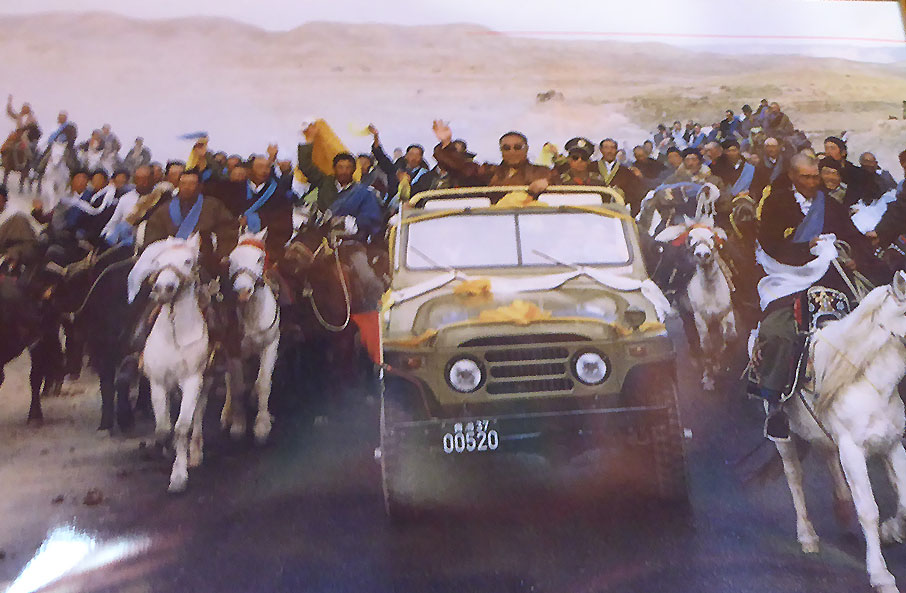 In this collaborative project begun in 2015, Tibetan colleagues and I explore the ongoing social life of the controversial Geluk-sect Tibetan Buddhist incarnate lama, the tenth Panchen Lama (1938-1989). To this day, most adult Tibetans in Amdo (Ch. Qinghai, SW Gansu and NW Sichuan provinces) mourn the lama's death because he was seen as the courageously outspoken medium and advocate to Chinese state leaders of modern Tibetan Buddhism, culture and language in the face of Maoist repression and assimilation pressures. Our ethnographic and historical research focuses on a crucial, yet hitherto relatively neglected time in the lama's tumultuous life, his triumphant early 1980s tours of his home region of Amdo. Those were the occasions when the rural faithful, reeling from the devastations of Chinese Communist Party collectivization campaigns and military crackdowns on Tibetan resistance (1958-78), were first able to see and interact with the Panchen Lama after his fourteen year detention for his high-profile criticisms of Maoist campaigns in Tibetan regions. By analyzing multi-media portrayals of those tours, our writings and multimedia projects will bring linguistic anthropological approaches to communication as embodied social action into dialogue with religious studies debates about Buddhist embodiment and the importance of materiality, media, and intersubjective practice in religious experience. Our project will thereby illuminate how the Panchen Lama's contested presence has embodied the life and death of Tibetan Buddhist worlds in post-Mao China.
In this collaborative project begun in 2015, Tibetan colleagues and I explore the ongoing social life of the controversial Geluk-sect Tibetan Buddhist incarnate lama, the tenth Panchen Lama (1938-1989). To this day, most adult Tibetans in Amdo (Ch. Qinghai, SW Gansu and NW Sichuan provinces) mourn the lama's death because he was seen as the courageously outspoken medium and advocate to Chinese state leaders of modern Tibetan Buddhism, culture and language in the face of Maoist repression and assimilation pressures. Our ethnographic and historical research focuses on a crucial, yet hitherto relatively neglected time in the lama's tumultuous life, his triumphant early 1980s tours of his home region of Amdo. Those were the occasions when the rural faithful, reeling from the devastations of Chinese Communist Party collectivization campaigns and military crackdowns on Tibetan resistance (1958-78), were first able to see and interact with the Panchen Lama after his fourteen year detention for his high-profile criticisms of Maoist campaigns in Tibetan regions. By analyzing multi-media portrayals of those tours, our writings and multimedia projects will bring linguistic anthropological approaches to communication as embodied social action into dialogue with religious studies debates about Buddhist embodiment and the importance of materiality, media, and intersubjective practice in religious experience. Our project will thereby illuminate how the Panchen Lama's contested presence has embodied the life and death of Tibetan Buddhist worlds in post-Mao China.
This project takes up my longstanding interest in history as a dynamic, intersubjective process. In our interview and translation work, my Tibetan colleagues and I are rethinking "oral history" from an anthropological perspective as collaborative historiography. Stories of the Tenth Panchen Lama's 1980s visits in fact participate in a nascent local history movement in Amdo since the mid-2000s, in which Tibetans are (re)framing their pasts in relation to contested and hoped for futures amidst rapid social change.
Related Publications/Projects/Courses
- (2020). (with Donyol Dondrup and Abho). "'I will never forget that day'": A conversation with former village leader Gabzang," in Robert Barnett, Benno Weiner and Francoise Robin, eds., Re-remembering Early Contact between Tibetans and the Chinese Communist Party in the post-Mao Period. Brill.
- (2018). (with Donyol Dondrup). "The Body Hair that Grows on the Head: Manla-kyab's 'Views on Hair and Hairstyles' (2009)," in Francoise Robin, Nicola Schneider, and Nicholas Sihle, eds., Trichologie Tibetaine, Ateliers d'anthropologie 45.
- (2018). Ch. 4 "The Melodious Sound of the Right-Turning Conch: Historiography and Buddhist Counterdevelopment in Langmo Village," The Battle for Fortune: State-Led Development, Personhood, and Power Among Tibetans in China. Cornell University Press and Weatherhead East Asian Institute.
- (2013). "Rebgong's Klu rol, Historiography, and the Politics of Presence: Methodological Considerations," in Unity and Diversity: Monastic and Non-monastic Traditions in North-east Tibet. Yangdon Dhondup, Ulrich Pagel, Geoffrey Samuels. eds. Leiden: Brill.
- (2008). "The Politics of Memory: Gender, Autobiography and Maoist Violence in Amdo," Conflict and social order in Tibet and inner Asia, Fernanda Pirie and Toni Huber, eds. Leiden ; Boston: Brill.
- (2005). "Speaking Bitterness: Autobiography, History and Mnemonic Politics on the Sino-Tibetan Frontier," in Comparative Studies in Society and History 47(1): 40-78, January.
- Interactive Media: Rent Collection Courtyard
- Media Archive: Wrath of the Serfs
Personhood, Power and State-led Development in Rebgong (NE Amdo, SE Qinghai Province) (funded by American Council for Learned Societies Fellowship 2014-2015) (Honorable Mention, E. Gene Smith Book Prize in Inner Asian Studies, 2020)
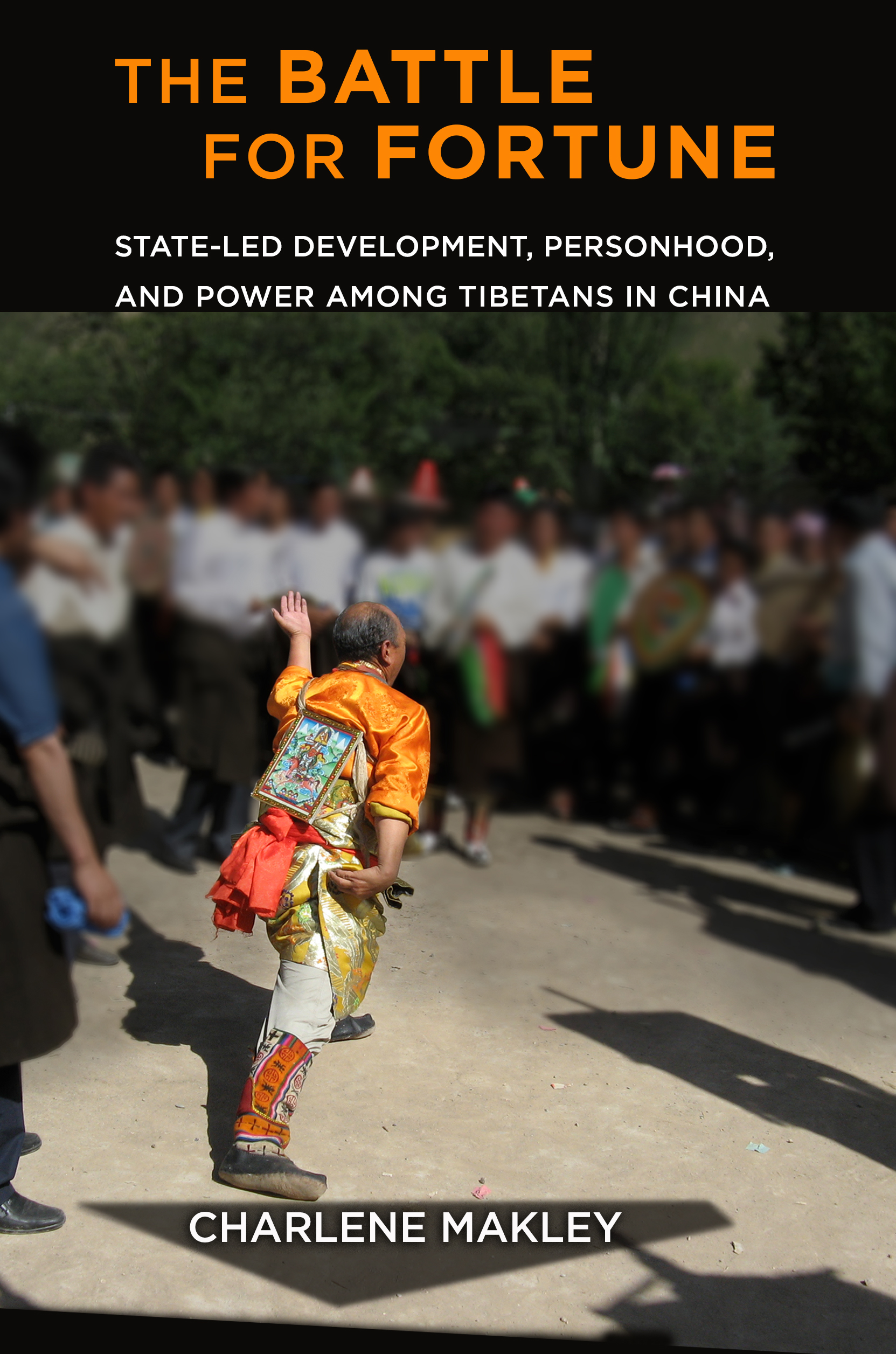 I began working on this project in the early 2000s, just after China's central leaders launched the Great Develop the West campaign (Ch. Xibu Da Kaifa), producing new dilemmas for Tibetans as circulations of people, money and information intensified in the frontier zone. For this project, I moved to a new, but historically related research site in Rebgong, a few mountain passes to the northwest of Labrang and site of the famous Geluk-sect Buddhist monastery of Rongwo. I carried out the primary fieldwork for this research in 2007-2008, during the tumultuous period leading up to and beyond the widespread Tibetan unrest that spring, the massive Sichuan earthquake, and the great spectacle of the Beijing Olympics. In this research, I deepened my analysis of state-local relations in the frontier zone in the wake of the 2008 state of emergency. I did this by bringing linguistic anthropological approaches to personhood, governance and authority into dialogue with recent interdisciplinary debates about the very nature of human subjectivity and relations with nonhuman others (including deities and material objects).
I began working on this project in the early 2000s, just after China's central leaders launched the Great Develop the West campaign (Ch. Xibu Da Kaifa), producing new dilemmas for Tibetans as circulations of people, money and information intensified in the frontier zone. For this project, I moved to a new, but historically related research site in Rebgong, a few mountain passes to the northwest of Labrang and site of the famous Geluk-sect Buddhist monastery of Rongwo. I carried out the primary fieldwork for this research in 2007-2008, during the tumultuous period leading up to and beyond the widespread Tibetan unrest that spring, the massive Sichuan earthquake, and the great spectacle of the Beijing Olympics. In this research, I deepened my analysis of state-local relations in the frontier zone in the wake of the 2008 state of emergency. I did this by bringing linguistic anthropological approaches to personhood, governance and authority into dialogue with recent interdisciplinary debates about the very nature of human subjectivity and relations with nonhuman others (including deities and material objects).
Related Publications/Projects/Courses
- (2020). #AsiaNow Speaks with Charlene Makley. (Interview about The Battle for Fortune for E. Gene Smith Inner Asia Book Prize).
- (2020) Podcast on The Battle for Fortune for New Books Network.
- (2018). The Battle for Fortune: State-Led Development, Personhood, and Power Among Tibetans in China. Cornell University Press and Weatherhead East Asian Institute.
- (2017). "The Abstract State: Dilemmas of Sovereignty and Scale Among Tibetans in China," in Adrian Zenz, Jarmilla Ptackova, and Elise Cencetti, eds., Amdo: Dynamics of Change, Brill.
- (2016). “Khedrup Gyatso: Monk Between Worlds,” in Jeffrey Samuels, Mark Rowe, and Justin McDaniel eds., Figures of Buddhist Modernity in Asia. University of Hawaii Press.
- (2015). "The Sociopolitical Lives of Dead Bodies: Tibetan Self-‐Immolation Protest as Mass Media," Cultural Anthropology Journal 30:3.
- (2014). "Spectacular Compassion: "Natural" Disasters and National Mourning in China's Tibet," Critical Asian Studies 46 (3).
- (2014). "The Amoral Other: State-led Development and Mountain Deity Cults among Tibetans in Amdo Rebgong," in Emily Yeh and Chris Coggins, eds., Mapping Shangrila: Nature, Personhood, and Polity in the Sino-Tibetan Borderlands. Seattle: University of Washington Press.
- (2013, July). "The Politics of Presence: Voice, Deity Possession, and Dilemmas of Development Among Tibetans in the PRC,"Comparative Studies in Society and History 55 (3): 665-700.
- (2013). "Rebgong's Klu rol and the Politics of Presence: Methodological Considerations," in in Unity and Diversity: Monastic and Non-monastic Traditions in North-east Tibet. Yangdon Dhondup, Ulrich Pagel, Geoffrey Samuels. eds. Leiden: Brill.
- (2012). "The Political Lives of Dead Bodies," in Cultural Anthropology Journal Hot Spot Forum: Self-Immolation as Protest in Tibet (April).
- (2009). "Ballooning Unrest: Tibet, State Violence and the Incredible Lightness of Knowledge," in China in 2008: a Year of Great Significance, Kate Merkel-Hess, Kenneth L. Pommeranz, and Jeffrey Wasserstrom, ed.s, Lanham: Rowman and Littlefield, Inc.: pp. 44-55.
- Course: "Global Tibet," Anth 364, upper level seminar
- Course: “The Anthropology of Development in Post-Mao China”Anth 365, upper level seminar.
- Course: "Ethnicity and Gender in China and Tibet,"Anth 362, upper level seminar
- Media Archive: Visions of Value
Gender and Monastic Revival in Labrang (NE Amdo, SW Gansu province)
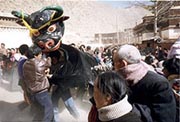 I began working in the famous Tibetan Buddhist monastery town of Labrang (Ch. Xiahe) in 1992, when I first traveled there with Tibetan friends. At the time, those regions had only recently opened to foreign travelers and researchers. Because of the region's former centrality as a powerful monastic polity in dialogue with other imperial powers, I was interested in understanding how Tibetans in Labrang were rebuilding and transforming their communities after the collective trauma of socialist transformation (1950s-70s) and in light of the massive transformations of the 1980s 'reform and opening up' era. Drawing on feminist and postcolonial theory in anthropology and related disciplines, I argued in a variety of publications that the cultural politics of ethnicity, nationalism, monastic revival and state-led economic development were fundamentally gendered processes shaping the lives of both men and women in powerful, but sometimes deeply ambivalent ways.
I began working in the famous Tibetan Buddhist monastery town of Labrang (Ch. Xiahe) in 1992, when I first traveled there with Tibetan friends. At the time, those regions had only recently opened to foreign travelers and researchers. Because of the region's former centrality as a powerful monastic polity in dialogue with other imperial powers, I was interested in understanding how Tibetans in Labrang were rebuilding and transforming their communities after the collective trauma of socialist transformation (1950s-70s) and in light of the massive transformations of the 1980s 'reform and opening up' era. Drawing on feminist and postcolonial theory in anthropology and related disciplines, I argued in a variety of publications that the cultural politics of ethnicity, nationalism, monastic revival and state-led economic development were fundamentally gendered processes shaping the lives of both men and women in powerful, but sometimes deeply ambivalent ways.
Related Publications/Projects/Courses
- (2010). "Minzu, Market and the Mandala: National Exhibitionism and Tibetan Buddhist Revival in Post-Mao China." in Faiths on Display, Timothy Oakes and Donald Sutton, eds. Routledge.
- (2007). The Violence of Liberation: Gender and Tibetan Buddhist Revival in Post-Mao China, University of California Press. Reviewed in: American Ethnologist, The China Journal, J. of American Academy of Religion, Politics and Religion, Asian Studies Review, China Review International, J. of Gender Studies, Gender, Place and Culture. Religious Studies Review.
- (2005). "Speaking Bitterness: Autobiography, History and Mnemonic Politics on the Sino-Tibetan Frontier," in Comparative Studies in Society and History 47(1): 40-78, January.
- (2003). "Gendered Boundaries in Motion: Space and Identity on the Sino-Tibetan Frontier," American Ethnologist 30(4) (November ).
- (2002). "On The Edge of Respectability: Sexual Politics on the Sino-Tibetan Frontier," positions: east asia cultures critique 10(3): 575-630.
- (1998). “The Power of the Drunk: Humor and Resistance in China’s Tibet,” Jennifer Dickinson et al, (eds.), Linguistic Form and Social Action, Michigan Discussions in Anthropology 13: 39-79.
- Course: "Global Tibet," Anth 364, upper level seminar
- Course: “The Anthropology of Development in Post-Mao China” Anth 365, upper level seminar.
- Course: "Ethnicity and Gender in China and Tibet," Anth 362, upper level seminar
- Image Archive: Wrath of the Serfs
Performativity as Semiotic Practice
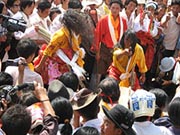 Drawing on lines of inquiry from American pragmatics to Prague School 'translinguistics', this rubric allows me to bring my training in linguistic anthropology into dialogue with broader debates about the nature of subjectivity, action, power, materiality and meaning. I find in this approach the most illuminating links among studies of language use, performance, ritual and media; it grounds my analysis in my most recent project on the collaborative historiography of the Tenth Panchen Lama, as well as in several journal articles and in my first and second book projects.
Drawing on lines of inquiry from American pragmatics to Prague School 'translinguistics', this rubric allows me to bring my training in linguistic anthropology into dialogue with broader debates about the nature of subjectivity, action, power, materiality and meaning. I find in this approach the most illuminating links among studies of language use, performance, ritual and media; it grounds my analysis in my most recent project on the collaborative historiography of the Tenth Panchen Lama, as well as in several journal articles and in my first and second book projects.
Related Publications/Projects/Courses
- (2018). Chapters 1-4, The Battle for Fortune: State-Led Development, Personhood, and Power Among Tibetans in China. Cornell University Press and Weatherhead East Asian Institute.
- (2017). "The Abstract State: Dilemmas of Sovereignty and Scale Among Tibetans in China," in Adrian Zenz, Jarmilla Ptackova, and Elise Cencetti, eds., Amdo: Dynamics of Change, Brill.
- (2013, July). "The Politics of Presence: Voice, Deity Possession, and Dilemmas of Development Among Tibetans in the PRC," Comparative Studies in Society and History 55 (3): 665-700.
- (2005). "Speaking Bitterness: Autobiography, History and Mnemonic Politics on the Sino-Tibetan Frontier," in Comparative Studies in Society and History 47(1): 40-78, January.
- (1998). “The Power of the Drunk: Humor and Resistance in China’s Tibet,” Jennifer Dickinson et al, (eds.), Linguistic Form and Social Action, Michigan Discussions in Anthropology 13: 39-79.
- Course: Language, Culture, Power, Anth 201, Introductory seminar
- Course: Media, Persons, Publics, Anth 397, Upper level seminar
- Course: "Performance and Performativity", Anth 411, Advanced seminar
The Cultural Politics of Sex, Gender and Sexuality
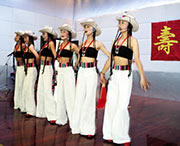 Coming out of the feminist anthropology collective formed among graduate students at the University of Michigan in the 1990s, my approach to sex, gender and sexuality brings earlier anthropological critiques of biological determinisms into dialogue with more recent feminist, critical race/ethnicity, queer and transgender theory. In this, I consider femininities, masculinities, nonbinary identities and their associated sexualities to be foundational sites of person and place-making across scales (from the most intimate of encounters to the most public and transregional relations). This approach grounds my analysis in my first book, as well as in several journal articles.
Coming out of the feminist anthropology collective formed among graduate students at the University of Michigan in the 1990s, my approach to sex, gender and sexuality brings earlier anthropological critiques of biological determinisms into dialogue with more recent feminist, critical race/ethnicity, queer and transgender theory. In this, I consider femininities, masculinities, nonbinary identities and their associated sexualities to be foundational sites of person and place-making across scales (from the most intimate of encounters to the most public and transregional relations). This approach grounds my analysis in my first book, as well as in several journal articles.
Related Publications/Projects/Courses
- (2018). "Intersectionality," entry for Jeffrey Di Leo, ed., Bloomsbury Handbook to Literary and Cultural Theory.
- (2015). "On the Edge of Respectability: Sexual Politics in China’s Tibet" in The Gender, Culture, Power Reader, Dorothy Hodgson, ed., Oxford: Oxford University Press.
- (2014). "The Amoral Other: State-led Development and Mountain Deity Cults among Tibetans in Amdo Rebgong," in Emily Yeh and Chris Coggins, eds., Mapping Shangrila: Nature, Personhood, and Polity in the Sino-Tibetan Borderlands. Seattle: University of Washington Press.
- (2008). "The Politics of Memory: Gender, Autobiography and Maoist Violence in Amdo," Conflict and social order in Tibet and inner Asia, Fernanda Pirie and Toni Huber, eds. Leiden ; Boston: Brill.
- (2004). "The Body of a Nun: Nunhood and Gender in Contemporary Amdo," Hanna Havnevik and Janet Gyatso, (Eds.), Women of Tibet. New York: Columbia University Press.
- (2003). "Gendered Boundaries in Motion: Space and Identity on the Sino-Tibetan Frontier," American Ethnologist 30(4) (November).
- (2002). "On The Edge of Respectability: Sexual Politics on the Sino-Tibetan Frontier," positions: east asia cultures critique 10(3): 575-630.
- (1997). "The Meaning of Liberation: Representations of Tibetan Women," The Tibet Journal 22(2): 4-29.
- Course: The Anthropology of Sex and Gender, Anth 344, upper level seminar
- Course: Ethnicity and Gender in China and Tibet, Anth 362, upper level seminar
- Media Archive: Sexism and Racism in Advertising
